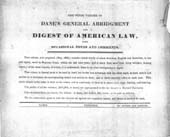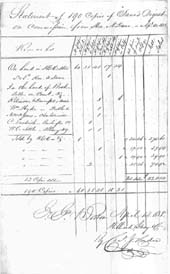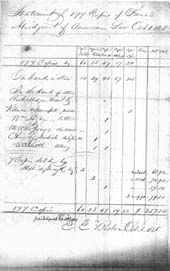 |
| Collaboration home |
 |
|
Figure 1: All of the profits Dane earned from the sale of his books was donated to Harvard to build the Law School. (Massachusetts Historical Society) |
 |
| Figure 2: "Statement of 190 copies of Dane's Digest on Commission from Hon. N. Dane" (Massachusetts Historical Society) |

Nathan Dane's American Law
By
Rebecca Engle
Submitted to Mr. Eastman
Department of History
Beverly, Massachusetts
21 January 2002
In early American Law, one document stands out as the first and most widely used piece of literature when one is referring to legal issues. That document is a book, (which eventually became a series of nine volumes) by Nathan Dane. Through his collection of books, titled A General Abridgment and Digest of American Law with Occasional Notes and Comments, Dane attempted to accomplish what no other American author of law had done before: to write a collection that could be used as a reference to any legal situation imaginable.
Nathan Dane, a Beverly, Massachusetts Lawyer, was born in 1752 and lived until 1835. Throughout his life, he was involved in many important historical happenings, including the Northwest Ordinance, the Hartford Convention, and even a temperance society. Dane was very much involved in American politics and he held office in several different political positions. However, sometime around the year 1815, Dane began to be absent from important conventions and meetings. This absence was a result of his hearing loss, which eventually became complete deafness. Rather than giving in to his old age and deteriorating health like most men might have done, Dane rose above his disability and made use of his newly found free time. During the years of 1815 and 1830, Dane researched, wrote, and revised his nine volume series on American Law.[1]
Dane's contribution of his Digest to American law was very significant for several different reasons. First of all, as mentioned, no other book like it had been written for American Law, so its existence was crucial to lawyers, law professors, and law students across America. Also significant is the fact that all of the profits Dane earned from the sale of his books ended up being donated to Harvard in order to build up a strong Law School. (figure 1) The most influential significance of Dane's series on American Law however, is the fact that all of his efforts in writing down American Law were ultimately geared towards nationalizing law.[2]
In Dane's own Prospectus or concise view of his book, he explains how his writings will be useful to those who read them. Dane believed it would use about eight volumes (in reality, nine) to contain all the information he was prepared to share. Dane also believed his work would be most useful to students, primarily those studying law. Dane's book's objective was to combine all of America's laws, including the Magna Carta and the Colonies' initial statutes of law, and provide a ground work to which all legal cases could refer. Furthermore, Dane's book would contain actual judicial decisions made in the highest courts as examples of how law should be practiced.[3]
Dane realized that different laws applied to different States, therefore he chose Massachusetts (which still included the land that would become the state of Maine in 1820) to be the state represented in his book of law so that he would not have to list every single discrepancy between all the different Sates.[4] By using just Massachusetts as the example, he would be able to look deeply into its laws and use them as the model. Also, since Massachusetts was one of the first organized colonies, it already set up somewhat of a model for all other states' laws to follow. By using such specific laws as examples in his book, Dane wished to help even other states follow suit, thus nationalizing one uniform law.
Dane believed the forming of his general abridgment to American law was crucial in order to create a better knowledge of American law and prompt a more serious study of it. To create the most simple form for studying law critically, Dane arranged the books in specific orders, making sure ideas of law were somewhat connected so the reader would not be confused. He described one of the books as being broken down into twenty-eight divisions, 228 chapters, and being all in alphabetical order.[5] Dane's favor was obviously with the readers of his abridgment; he specified what each article would be about before it began so that the reader could choose what to spend time on studying. Even in his Prospectus, he lists every single division and its content. Dane, apparently, was a very organized individual. Not only did Dane want to make his books easy to study, he wanted them to be easily attainable as well. As seen in his own handwritten receipts for his books, he charged about $5.50 for each volume. If one could not afford that, Dane accepted the price's equivalent in sheep or boards. Another example of Dane's generosity is apparent through the correspondence he kept with a man from Indiana, Mr. John Farnham. Farnham had been involved in the Northwest Ordinance with Dane, and was also involved with Indiana's Historical Society. Sometime during this correspondence, which occurred between the years of 1830 and 1831, Dane offered Farnham a complete collection of his nine volumes of American Law.[6] Yet another document, a letter, shows that Dane was not reserved in giving away copies of his book. The letter is from a man thanking Dane for sending him a collection of the Digests, to which his "most respectful acknowledgment." What's significant is the signature on this letter: it belongs to John Quincy Adams!
One of Dane's other close friends and a fellow lawyer, Judge Joseph Story, wrote at the end of Dane's Prospectus a sort of summary of Dane's achievements and credibility. Story says Dane was known to study for fourteen hours out of every day without becoming prone to weariness.[7] He notes that as early as 1782, Dane was aware that America's law had not been properly recorded in print since the early Colonial days and was in a very chaotic state. Dane's answer to this problem was to select portions of the English law, incorporate them with America's constitutions, statutes, and judicial laws, and turn them into a ground work of American law to be used by anyone to whom it was made available. After Dane accomplished that much, his new goal was to continue doing that with all the newly added laws until a whole system was available.
Dane's work truly did become a very valuable and necessary piece of literature to lawyers and students in his time and long after; a legacy to law in a way. It was the first book of its type to be written at that point, and was of great importance to the law of America. Not only was his book important, but was also well-received by the general public. Many documents still exist that prove how many of his books were sent out to be sold in different stores around the nation (See Figure 2 & Figure 3). Even at the rate of $5.00 or so per book, Dane was able to successfully sell enough copies of the book to donate a good $10,000 of the profits to Harvard Law School. He did not just leave it at that either. In order to make sure his money would be put to good use at the school, Dane provided a list of specifications that Harvard would have to meet in order for them to receive the money. Dane wanted Joseph Story to be the first incumbent at the Harvard Law School to make use of the money, but wanted to be sure that "he and successive professors would publish works on the law…"[8]
Dane's book was not only a first in its field, it was also generally an outstanding book which was impeccably organized and was easy for people to purchase. The way he blended the writing styles of a commentary and an abridgment and created a textbook format for the two was unheard of, but greatly appreciated.[9] Nathan Dane truly changed the way American Law was written, read, and studied. This man should not be hidden amongst other nameless men and women in American History. His accomplishments and involvement in important historical occurrences alone should have made him renowned throughout the years. However, since that did not seem to be enough yet, perhaps the inscription on his grave, a final tribute from his friend Joseph Story will be a good reminder: "His fame belongs to his country; Let the gratitude of future ages cherish it."[10]
References
Dane, Nathan. Prospectus, or Concise View of a General Abridgment and Digest
of American Law with Occasional Noted and Comments. Boston: 1822. Found at the Massachusetts Historical Society, Boston, MA.Dane, Nathan. Various Papers and Receipts. Found at the Massachusetts
Historical Society, Boston, MA.Johnson, Andrew J. The Life and Constitutional Thought of Nathan Dane.
New York: Garland Publishing, 1987.Stone, Edwin M. History of Beverly, Civil and Ecclesiastical, From its Settlement in 1630 to 1842. Boston: James Munroe and Company, 1843.
Various Documents: Letters, professional papers, and personal papers all found at the Massachusetts Historical Society in Nathan Dane's Papers, Boston, Massachusetts.
[1] Andrew J. Johnson, The Life and Constitutional Thought of Nathan Dane (New York: Garland Publishing, 1987) 2.
[3] Nathan Dane, Prospectus or Concise View Of a General Abridgment and Digest of American Law, with occasional Notes and Comments (Boston, Massachusetts: 1822, Available at the Massachusetts Historical Society, Boston, Massachusetts) 1-16.
[6] Letters between Nathan Dane and John Farnham, (1830-1831, Available at the Massachusetts Historical Society, Boston, Massachusetts)
[7] Nathan Dane, Prospectus or Concise View Of a General Abridgment and Digest of American Law, with occasional Notes and Comments (Boston, Massachusetts: 1822, Available at the Massachusetts Historical Society, Boston, Massachusetts) 13-16. (Addendum to Dane's Prospectus, by Judge Joseph Story, Salem, Massachusetts, May, 1821)
[10] Johnson, 12. (Joseph Story's inscription on Dane's gravestone, found on an undated document in Dane's files at the Beverly Historical Society, Beverly, Massachusetts)
 |
| Figure 3 : "Statement of 144 copies of Dane's Abridgement of American Law" (Massachusetts Historical Society) |
This page was last updated February 3, 2002. © 2002 Primary Research .org. Please send comments to comments@primaryresearch.org